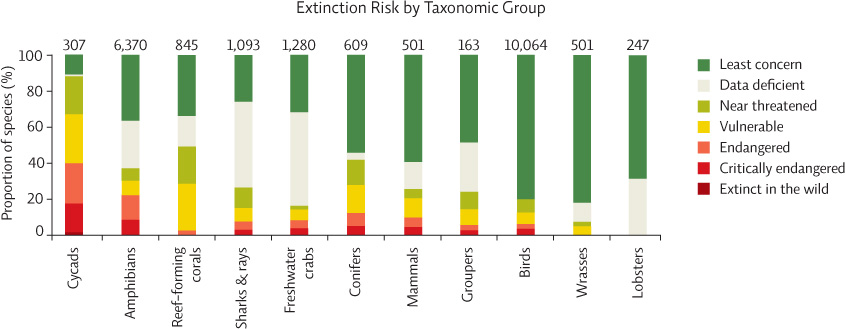SCIENCE LITERACY WORKING WITH DATA
The International Union for Conservation of Nature (IUCN) has maintained an inventory, called the “Red List,” of the extinction risk for the world’s species since 1963. Look at the following IUCN graph and answer the next five questions.

Interpretation
1. Describe what the graph shows about the proportion of cycad species in each category.
A very small amount (about 1%) are extinct in the wild, about 17% are critically endangered, about 22% are endangered, 22% are vulnerable, 22% are near threatened, 1% are in the “data deficient” category, and 15% are of “least concern.”
2. Compare the proportion of threatened (critically endangered, endangered, vulnerable) amphibians to birds.
The proportion of threatened birds (~5%) is much lower than that of amphibians (~20%).
3. Compare the number of threatened amphibians to birds (Hint: The total number of species per group is at the end of each bar in the graph).
Amphibians: 0.20 x 6370 = 1274; Birds: 0.05 x 10,064 = 503. There are more amphibian species than bird species that are threatened.
Advance Your Thinking
4. Identify the three groups that contain the highest proportion of species that are “data deficient.” Why do you think less is known about species in these particular groups? How would you predict that extinction risk estimates would change if more were known about these species—that is, would a higher proportion be threatened, or would more be of “least concern”?
• Sharks & rays, crabs, lobsters
• These groups are aquatic and mobile, so are probably more difficult to observe.
• “Data deficient” species may be less well known because they are more rare; this would suggest that a higher proportion of species would be threatened if more were known. Alternatively, they may be in areas in which there are fewer humans to observe them (e.g., in the middle of the Pacific), which might mean that they have healthier populations, leading to a higher proportion of “least concern” species as more is known.
5. Many North American species of birds are migratory, spending winters in tropical regions (such as Central or South America) and summers in North America. Habitat destruction due to deforestation is one of the most common threats many of these species face. Suppose you spearheaded a program that returned adequate habitat to the migratory birds in your area. Why might this not be enough to allow the species to recover?
Because the birds also depend on habitat in their winter homes and along migratory routes, if those habitats were degraded, the birds might not survive to return to North America in the spring.